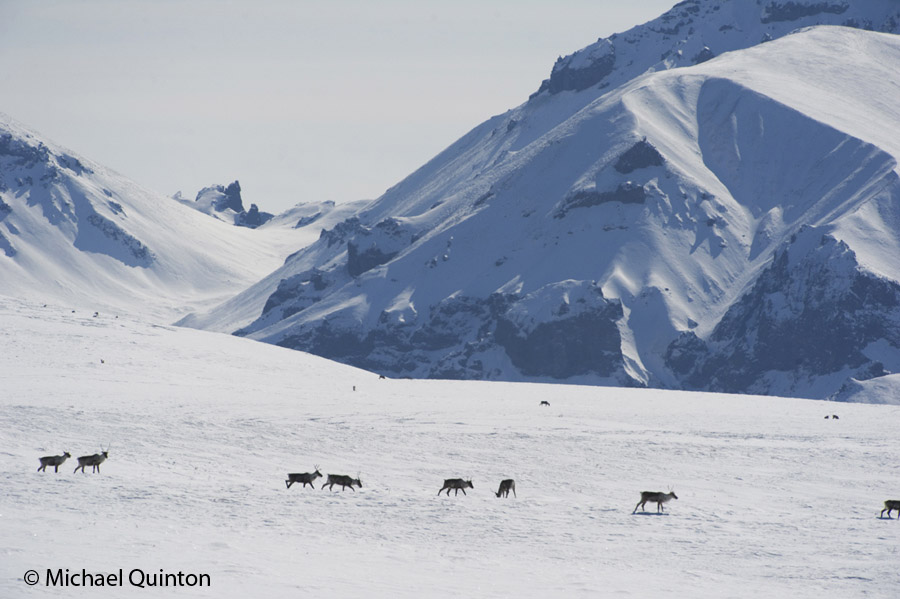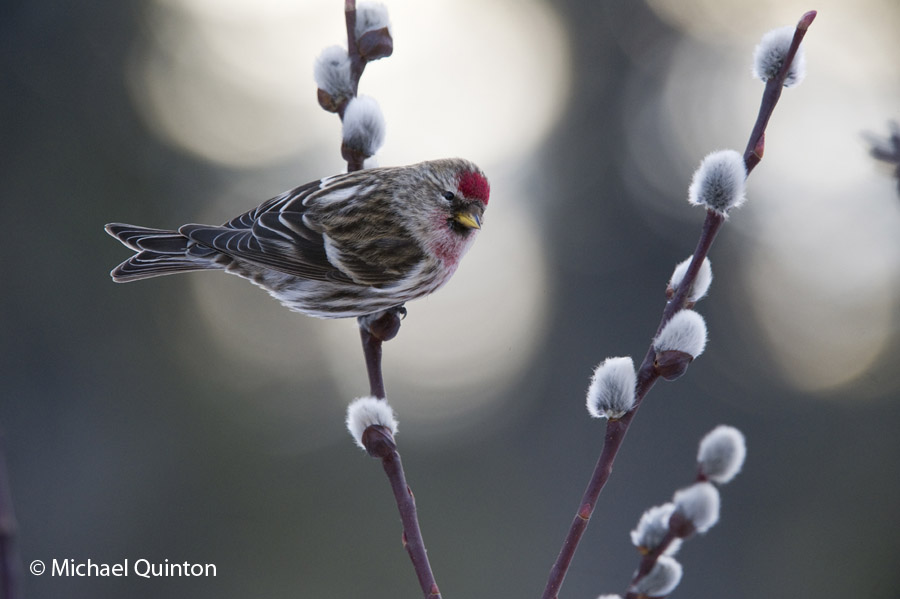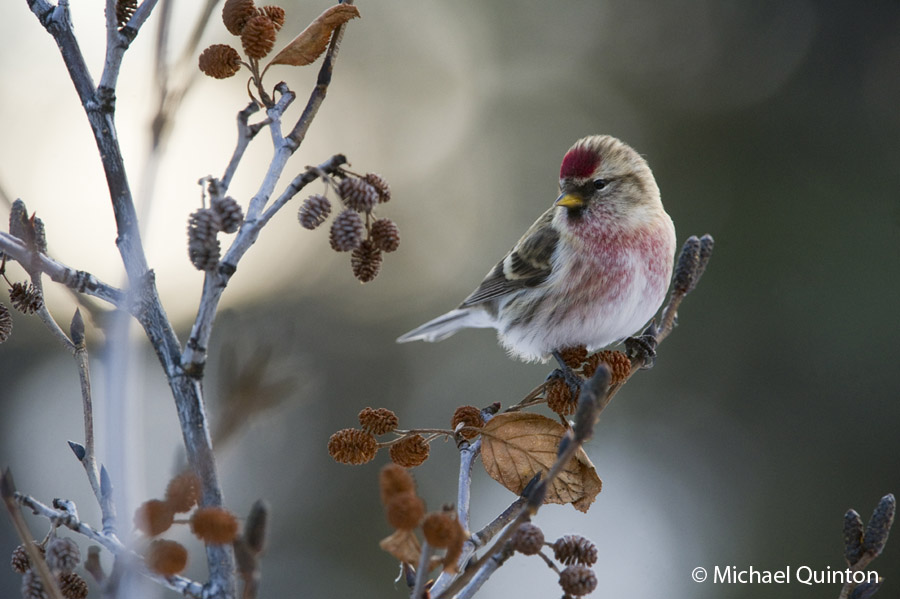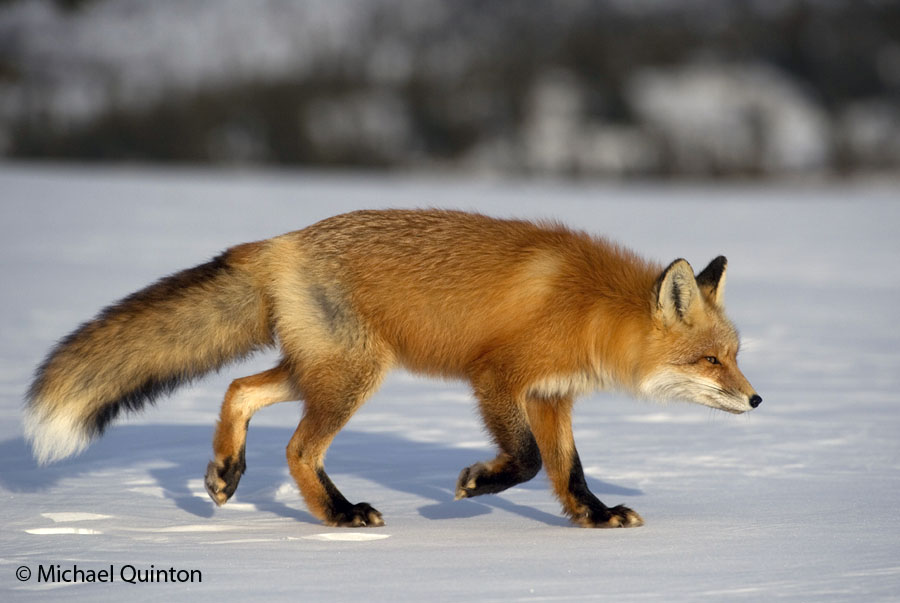 Caribou in the high country of Wrangell/St. Elias National Park.
Caribou in the high country of Wrangell/St. Elias National Park.

In my part of Alaska’s Interior we have two species of chickadees. These tiny and delightful birds cheer up the coldest day but are hard to photograph. The black-capped chickadee is often found in mixed habitats of spruce, willow, birch and aspen. The boreal chickadee is associated with the black spruce bog habitats. They are quick and refuse to stay put so you must be very quick yourself. One sure way just might be the oldest techique for bird photography out there. Simply pre-focus on a favorite perch and wait.
 On my last post I laid out a way to get close-up photographs of the very small and beautiful common redpoll. By setting up a feeding station early in the season you can get redpolls to come to you.
On my last post I laid out a way to get close-up photographs of the very small and beautiful common redpoll. By setting up a feeding station early in the season you can get redpolls to come to you.
Attention to a few photographic details can help you to get professional results. First, you’re choice of a location is very important. Some locations are more photogenic than others, obviously. Avoid situations that are complex. For example if your location is too thick with brush and vegetation then there will always be something in the way, branches, twigs, between you and your subject. Often, it is these kinds of distractions that can ruin an otherwise nice photo. Continue reading
 What a joy it is to observe common redpolls every day all winter long. When the bottom drops out of the thermometer they go about their cheerful, lively routine seemingly without regard to Interior Alaska’s dangerous temperatures. Redpolls are active from first light until sunset. Even at fifty below you will find them busy, usually in small groups feeding among bushes. But where they spend the nights is a mystery to me. They have been reported to spend some nights in snow burrows, like ptarmigan. Continue reading
What a joy it is to observe common redpolls every day all winter long. When the bottom drops out of the thermometer they go about their cheerful, lively routine seemingly without regard to Interior Alaska’s dangerous temperatures. Redpolls are active from first light until sunset. Even at fifty below you will find them busy, usually in small groups feeding among bushes. But where they spend the nights is a mystery to me. They have been reported to spend some nights in snow burrows, like ptarmigan. Continue reading
 The arrival of March in Interior Alaska is a wonderful change. Temperatures generally don’t stray much below twenty below F and the light is increasing by about thirty five minutes a week. It’s a great time to be out. Moose don’t really mind the cold in fact they might seek the shade even at fifty below zero because their huge bodies produce so much heat. Continue reading
The arrival of March in Interior Alaska is a wonderful change. Temperatures generally don’t stray much below twenty below F and the light is increasing by about thirty five minutes a week. It’s a great time to be out. Moose don’t really mind the cold in fact they might seek the shade even at fifty below zero because their huge bodies produce so much heat. Continue reading
 The red fox, Vulpes vulpes is one of nature’s most successful predators, thriving in a variety of habitats from tundra to desert, forest to mountains. Though common throughout their vast range, the red fox makes a tough photo subject. Continue reading
The red fox, Vulpes vulpes is one of nature’s most successful predators, thriving in a variety of habitats from tundra to desert, forest to mountains. Though common throughout their vast range, the red fox makes a tough photo subject. Continue reading
I’ve spent the last four afternoons looking for willow ptarmigan. One of my photographic goals is to document more of their interesting behavior. On top of that list of photo wants are photos of willow ptarmigan in their snow burrows. Ptarmigan use snow to help insulate them against the frigid winter temperatures of interior Alaska. Their use of snow burrows can occur any time of the day but most common as they prepare to roost for the night. Willow ptarmigan are cyclic and their numbers have been quite low over the past two or three winters. But as Justin pointed out, they seem to be bouncing back. Continue reading
You’re never too young to develop the skills of observation and a love of nature. Exploring the back yard forest with my two year and half year old granddaughter is my favorite kind of fun.
 The alder jungle. Continue reading
The alder jungle. Continue reading
 Keeping tabs on your local wildlife is an important task for the naturalist. Take note of the locations of nests of all kinds. Continue reading
Keeping tabs on your local wildlife is an important task for the naturalist. Take note of the locations of nests of all kinds. Continue reading